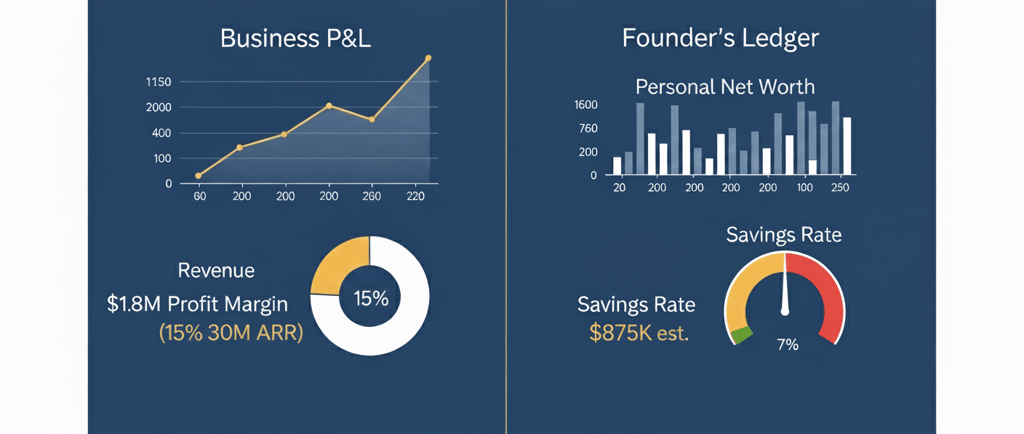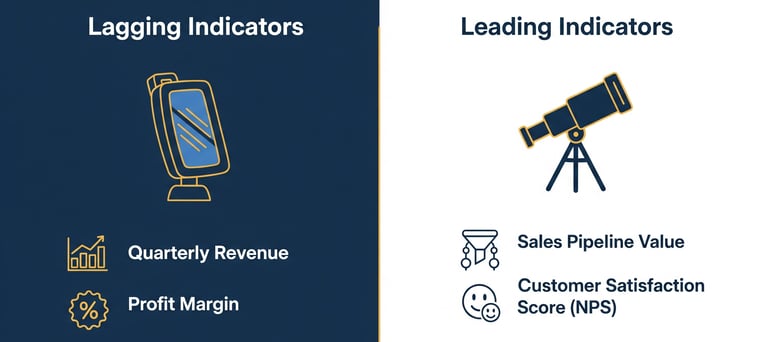From the CFO’s Ledger: Why Your Business P&L Is Only Half the Story
Your P&L shows record profits, but your personal account is stressed. Learn why this disconnect happens and how to achieve true financial symbiosis.
Zachary Scardino
9/8/2025


For most founders, success feels like a tale of two ledgers. The first is your company’s P&L, which might tell a great story of record revenue and healthy profit margins. The second is your personal bank account, which often tells a very different story—one of cash-flow anxiety and a feeling of being trapped by the very business you built for freedom.
If you’re leading a successful business but feel personally precarious, you’re not failing. You’re experiencing the Founder’s Paradox: the state of being asset-rich on paper but cash-poor in practice.
This chasm between reported success and your lived financial reality is a systemic problem. The tools we use to measure business health are misaligned with the metrics of personal prosperity. The entrepreneurial mindset, geared for growth at all costs, often prioritizes the business to the detriment of the founder’s own stability. This post will deconstruct the root causes of this disconnect and provide a clear path to achieving what should be your ultimate goal: true financial symbiosis, where the business serves your life as much as you serve the business.
The Great Disconnect: When Profit Doesn't Equal Prosperity
The core problem is that your financial statements are a rearview mirror. They are lagging indicators, telling you what has already happened. A profitable quarter is great, but it doesn't predict the future. A business can be profitable on paper and simultaneously on the verge of collapse.
This is because the P&L and Balance Sheet miss two critical things:
Leading Indicators: These are the predictive metrics that signal future outcomes. Think of customer satisfaction scores, employee engagement, or the health of your sales pipeline. We’ve seen founders with glowing P&Ls who were ignoring plummeting customer satisfaction—a leading indicator that future revenue was about to fall off a cliff. Your gut feels this tension, even when the numbers look good.
Intangible Assets: In today's economy, most of a company's value isn't in machinery or inventory; it's in intangible assets like your brand reputation, customer relationships, and team culture. According to Ocean Tomo, intangible assets now account for over 84% of the S&P 500's market value. Yet, under standard accounting rules, these critical drivers of value are invisible on your balance sheet. You can't manage what you don't measure.
The Founder's Financial Vise: Compensation, Risk, and "Phantom Income"
The mechanics of how you pay yourself and fund growth often create a financial vise, squeezing you between the demands of the business and your own financial survival.
The Compensation Conundrum (Salary vs. Distribution): For S Corp owners, taking a low "reasonable salary" and larger distributions can save on payroll taxes. However, this strategy obscures the true cost of leadership and can create valuation problems during an exit. It also creates personal income volatility, making it hard to budget and plan.
The "Phantom Income" Trap: As a pass-through entity, you are taxed on the business's profits in the year they are earned, regardless of whether you take that cash out. When you reinvest profits to fund growth, you create a personal tax liability without the corresponding cash distribution to pay it. This is how a highly "profitable" year can lead to a personal cash-flow crisis.
The Weight of Personal Guarantees: When you sign a personal guarantee for a business loan or lease, you pierce the corporate veil. The constant, underlying stress that a business downturn could lead to personal financial ruin takes an immense psychological toll, distorting your ability to make clear, long-term decisions.
From Gut-Feel to Data-Driven: A New Way to Measure What Matters
Breaking free from the Founder's Paradox requires a new operating system—one that provides clarity, enforces discipline, and aligns your business engine with your personal wealth goals.
The first step is to build a measurement system that tracks both leading and lagging indicators, giving you a complete, 360-degree view of business health. This moves you from reactive, gut-feel management to proactive, data-driven leadership.
The second step is to install a non-negotiable system for cash management. Methodologies like Profit First are powerful because they are behavioral. By pre-allocating every dollar of revenue to specific accounts—Profit, Owner's Pay, Tax, and Operating Expenses—you enforce discipline and make profitability a habit, not an afterthought. It ensures the business always serves you first.
Ultimately, your business should be the most powerful asset in your personal wealth portfolio, not an all-consuming job. By implementing the right frameworks for measurement and cash management, you can finally close the gap between your two ledgers and build a business that funds the life you want to live.


Growth
Driving your growth with clear, data-driven insights.
Success
connect@scardinostrategic.com
© 2025 Scardino Strategic Partners. All rights reserved.
Partner